
Spilostethus pandurus, Germasogeia (Yermasoyia), Cyprus, Photo: Augusta Stylianou Artist
Superregnum: Eukaryota
Cladus: Unikonta
Cladus: Opisthokonta
Cladus: Holozoa
Regnum: Animalia
Subregnum: Eumetazoa
Cladus: Bilateria
Cladus: Nephrozoa
Cladus: Protostomia
Cladus: Ecdysozoa
Cladus: Panarthropoda
Phylum: Arthropoda
Subphylum: Hexapoda
Classis: Insecta
Cladus: Dicondylia
Subclassis: Pterygota
Cladus: Metapterygota
Infraclassis: Neoptera
Cladus: Eumetabola
Cladus: Paraneoptera
Superordo: Condylognatha
Ordo: Hemiptera
Subordo: Heteroptera
Infraordo: Pentatomomorpha
Superfamilia: Lygaeoidea
Familia: Lygaeidae
Subfamilia: Lygaeinae
Genus: Spilostethus
Species: Spilostethus pandurus
Spilostethus pandurus is a species of "seed bugs" belonging to the family Lygaeidae, subfamily Lygaeinae.
Etymology
The species was described in 1763 by Scopoli in his "Entomologica carniolica" with locus typicus from the area around Ljubljana. Scopoli does not mention the etymology of the species name but may have named it for the Panduri infantry unit of the Habsburg monarchy.
Subspecies
Subspecies include:[2]
S. pandurus subsp. pandurus (Scopoli, 1763): Native to Albania, Austria, Bulgaria, Corsica, Crete, Crimea, Cyprus, Czech Republic, France, Germany, Greece, Hungary, Italy, Portugal, Russia, Sardinia, Spain, Switzerland, Yugoslavia, Algeria, Egypt, Libya, Morocco, Nigeria, Senegal, Sierra Leone, Slovakia, Sudan, Kenya, Arabia, Iran, Iraq, Israel and India.
S. pandurus subsp. militaris (Fabricius, 1775): Native to Albania, Austria, Belgium, Bulgaria, Corsica, Crete, Cyprus, Czech Republic, France, Germany, Greece, Italy, Majorca, Malta, Portugal, Romania, Russia, Sardinia, Sicily, Slovakia, Spain, Switzerland, Yugoslavia, Algeria, Egypt, Ethiopia, Libya, Morocco, Mozambique, Sahara, Senegal and Sierra Leone.
S. pandurus subsp. elegans (Wolff, 1802): Native to Central and Southern Africa, Canary Islands, India and Israel.
S. pandurus subsp. asiaticus (Kolenati, F.A., 1845): Native to Madagascar.
S. pandurus subsp. tetricus (Horvath, G., 1909): Native to the Canary and Madeira islands.
Distribution
This species can be found in the Euro-mediterranean-Turaniaan Region, with a more southern distribution than Spilostethus saxatilis.
It is present in Albania, Austria, Bulgaria, Croatia, Cyprus, Czech Republic, France, Germany, Greece, Hungary, Italy, Israel, Malta, Portugal, Romania, Russia, Serbia, Slovakia, Slovenia, Spain, Switzerland, Turkey, Lebanon, in the Afrotropical realm.[3] and in the southern Asia to India and China.
Description
Spilostethus pandurus can reach a length of 13–15 millimetres (0.51–0.59 in). Body shows a red-black coloration with a white spot in the center of the membrane.
Two wavy, broad, black, longitudinal stripes run from the front to the rear edge of the pronotum. Scutellum is black, sometimes with a small red spot at the end.[4][5]
The nymphs are bright red, with black markings.
These bugs have two dorsolateral prothoracic glands capable of secreting substances repugnant to predators.
Biology
These polyphagous bugs feed on flowers and seeds of many plants. They preferentially feed on the plants of the family Apocynaceae. In Europe, they are present on various toxic plants such as jimsonweed (Datura stramonium) and oleander (Nerium oleander).
They can cause serious damage to the crops of Sesamum indicum (Pedaliaceae) and to Calotropis gigantea and Calotropis procera (Apocynaceae).
It can also attack sorghum crops (Sorghum bicolor), Eleusine coracana, Pennisetum americanum, Phaseolus mungo, Arachis hypogaea, Lycopersicum esculentum, tobacco, sunflowers etc.[6]
References
Scopoli, I.A. (1763). Entomologia carniolica exhibens insecta carnioliae indigena et distributa in ordines, genera, species, varietates. Methodo Linnæana. Vindobonae [= Vienna]: Trattner. pp. [30] + 420 pp. Retrieved 23 June 2021.
"COL".
Fauna europaea
Keys at Les insectes (in French)
Natura Mediterraneo (in Italian)
Carl Walter Schaefer, Antonio Ricardo Panizzi, Heteroptera of economic importance, CRC Press, 2000
Retrieved from "http://en.wikipedia.org/"
All text is available under the terms of the GNU Free Documentation License

